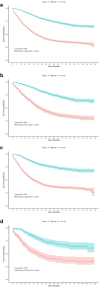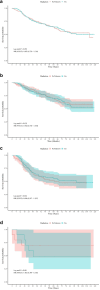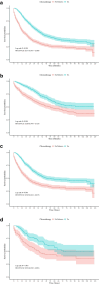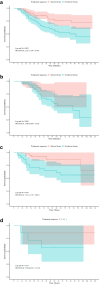Development and validation of cancer-specific survival prediction nomogram for patients with T4 stage colon cancer after surgical resection: a population-based study
- PMID: 40102264
- PMCID: PMC11920356
- DOI: 10.1007/s00384-025-04856-3
Development and validation of cancer-specific survival prediction nomogram for patients with T4 stage colon cancer after surgical resection: a population-based study
Abstract
Purpose: The increasing incidence of colorectal cancer has coincided with a rise in T4 stage colon cancer (CC), yet research on its prognosis remains limited. This study aimed to identify risk factors and develop a nomogram to predict cancer-specific survival (CSS), optimizing treatment strategies for different subgroups.
Methods: Using data from the from the Surveillance, Epidemiology, and End Results (SEER) database, we identified risk factors in T4 stage CC patients and created a nomogram to predict CSS. Patients were divided into low- and high-risk groups, and the nomogram was validated. Propensity score matching was used to evaluate the benefits of various therapies across subgroups.
Results: Independent risk factors, including T stage, N stage, tumor grade, age, and therapy sequence, were identified through Cox regression analyses and incorporated into the nomogram. The nomogram outperformed the American Joint Committee on Cancer (AJCC) 7th staging system, with a Concordance-index of 0.77 in both training and validation sets. The receiver operating characteristic curves showed area under the curve values of 0.81, 0.77, and 0.75 for 1-, 3-, and 5-year CSS, respectively. Calibration plots confirmed strong alignment between predicted and actual outcomes, and decision curve analysis highlighted the nomogram's superior clinical utility. Chemotherapy significantly improved CSS, while radiation did not. Adjuvant therapy was particularly beneficial in high-risk groups.
Conclusion: This study offered a thorough prognostic analysis of T4 stage colon cancer patients and developed nomograms for predicting CSS. Subgroup analyses highlight the potential benefits of various treatment options.
Keywords: Adjuvant therapy; Colon cancer; Nomogram; Surveillance, Epidemiology, and End Results; T4 stage.
© 2025. The Author(s).
Conflict of interest statement
Declarations. Ethical approval: The authors are accountable for all aspects of the work in ensuring that questions related to the accuracy or integrity of any part of the work are appropriately investigated and resolved. The study was conducted in accordance with the Declaration of Helsinki (as revised in 2013). Competing interests: The authors declare no competing interests.
Figures






Similar articles
-
Development and validation of predictive nomograms for survival in early-onset colon cancer patients with II-III stage across various tumor sites.Transl Cancer Res. 2025 Apr 30;14(4):2233-2249. doi: 10.21037/tcr-2024-2290. Epub 2025 Apr 27. Transl Cancer Res. 2025. PMID: 40386271 Free PMC article.
-
Conditional survival analysis and real-time prognosis prediction in stage III T3-T4 colon cancer patients after surgical resection: a SEER database analysis.Int J Colorectal Dis. 2024 Apr 19;39(1):54. doi: 10.1007/s00384-024-04614-x. Int J Colorectal Dis. 2024. PMID: 38639915 Free PMC article.
-
Development and validation of a nomogram for predicting cancer-specific survival in small-bowel adenocarcinoma patients using the SEER database.World J Surg Oncol. 2024 Jun 7;22(1):151. doi: 10.1186/s12957-024-03438-x. World J Surg Oncol. 2024. PMID: 38849854 Free PMC article.
-
Development and validation of survival prediction nomograms for patients with early-stage rectal cancer: a population-based study.Transl Cancer Res. 2025 Apr 30;14(4):2367-2380. doi: 10.21037/tcr-24-1888. Epub 2025 Apr 14. Transl Cancer Res. 2025. PMID: 40386280 Free PMC article.
-
A nomogram to predict postoperative overall and cancer specific survival in patients with primary parotid squamous cell carcinoma: a population based study.Sci Rep. 2025 Feb 25;15(1):6774. doi: 10.1038/s41598-025-90480-8. Sci Rep. 2025. PMID: 40000793 Free PMC article.
References
-
- Bray F, Laversanne M, Sung H et al (2024) Global cancer statistics 2022: GLOBOCAN estimates of incidence and mortality worldwide for 36 cancers in 185 countries. CA Cancer J Clin 74:229–263 - PubMed
-
- Patel SG, Dominitz JA (2024) Screening for colorectal cancer. Ann Intern Med 177:Itc49-itc64 - PubMed
-
- Chen M, Chen T (2023) Individualized conditional survival nomograms for stage I-III early onset colorectal cancer patients. Jpn J Clin Oncol 53:115–121 - PubMed
-
- Zheng X, Cen W, Zhu J et al (2023) Prognostic value of tumor deposits in stage III colorectal cancer patients with different N stages: a population-based, retrospective cohort study. Ann Surg Oncol 30:8067–8073 - PubMed
-
- Bastiaenen VP, Aalbers AGJ, Arjona-Sánchez A et al (2021) Risk of metachronous peritoneal metastases in patients with pT4a versus pT4b colon cancer: an international multicentre cohort study. Eur J Surg Oncol 47:2405–2413 - PubMed
Publication types
MeSH terms
Grants and funding
LinkOut - more resources
Full Text Sources

